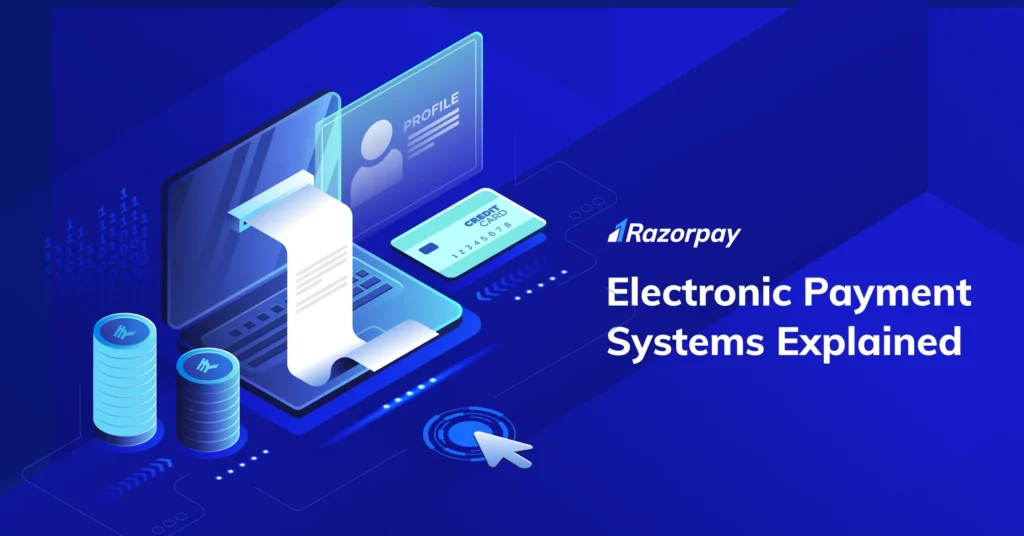In today’s digital economy, the landscape of financial transactions is rapidly evolving, with electronic payment systems leading the charge. These systems have revolutionized how we handle money, from facilitating online shopping to enabling contactless payments.
But what exactly is an electronic payment system (e-payment system)? This article explores how electronic payment systems work, the benefits of adopting them, and the macroeconomic trends influencing their growth today.
Table of Contents
What is Electronic Payment System?
An electronic payment system (EPS) is a digital method of transferring funds between individuals or businesses using electronic mediums like mobile apps, online banking, POS terminals and a range of payment methods. EPSs provide a secure, efficient, and convenient alternative to traditional payment methods such as cash, cheques, or digital currency.
E payment systems streamline financial transactions by enabling quick and paperless payments, reducing costs, and enhancing accessibility for users and businesses alike.
Besides, electronic payment systems have revolutionized the way we handle our finances, making transactions quicker, more efficient, and accessible to anyone with a bank account. By eliminating the need for physical currency, e-payment systems have significantly reduced transaction costs, eliminated paperwork, and even reduced labour costs for businesses.
How Does the Electronic Payment System Work?
Electronic payment systems (E-payments) are sophisticated platforms that facilitate the transfer of funds between parties, often initiated from one bank account to another. Here’s a step-by-step explanation of how electronic payments typically operate:
1. Entering Payment Information
When making a purchase or initiating a transfer, users enter their payment information into the system. This could be credit card details, bank account numbers, or digital wallet credentials.
2. Payment Gateway
The payment information is then sent to a payment gateway, which acts as a bridge between the user, the merchant, and the financial institution. The payment gateway plays a crucial role in approving or denying payment requests.
Related Read: Payment Aggregator vs Payment Gateway
3. Validation and Security
Before processing the transaction, the system validates the payment information to ensure it is accurate and legitimate. Stringent security protocols and encryption techniques are employed to safeguard the data during transmission, making electronic payments highly secure.
4. Transaction Processing
Once the payment is approved, the transaction is processed, and the funds are transferred from the user’s account to the merchant’s account or the recipient’s account.
Further, E payments can be broadly categorized into two main types: one-time payments and recurring payments. Each serves a unique purpose in facilitating transactions between customers and service providers or vendors.
Related Read: POS Transaction: Meaning, Types, Examples
Types of Electronic Payment System
Here are examples of Electronic Payment Systems:
1. Card Payments: Credit and Debit Cards
Credit and debit cards have become ubiquitous in our daily lives. They allow us to make purchases by simply swiping our cards at the point of sale. These cards are linked to our bank accounts, enabling us to spend within our financial means or borrow money (in the case of credit cards) for a limited period.
Related Read: What is the Point-of-Sale (POS) limit For Debit Cards?
2. Electronic Fund Transfers
Electronic fund transfers, such as National Electronic Funds Transfer (NEFT) and Real Time Gross Settlement (RTGS), provide a quick and secure way to transfer money between bank accounts. NEFT is typically used for smaller transactions, while RTGS is reserved for larger, time-sensitive transfers.
3. Online Bank Transfers
Online bank transfers allow individuals to move money directly from their bank accounts to another party’s account. This method is often used for bill payments and peer-to-peer transactions.
One example of online bank transfers is when you pay your monthly utility bills directly from your bank account through the utility company’s online payment portal. It’s a secure and convenient way to handle regular or recurring payments.
4. Virtual Payment Cards
Virtual payment cards are digital versions of physical credit or debit cards. They can be used for online purchases without exposing your actual card details. Virtual cards enhance security and reduce the risk of fraud.
Imagine using a virtual payment card to make an online purchase from a new, unfamiliar website. By doing so, you’re safeguarding your actual card details while enjoying the benefits of secure transactions, minimizing the risk of unauthorized use of your card.
5. Digital Wallets
Digital wallets, such as PayPal, Apple Pay, and Google Pay, have gained popularity for their convenience. Users can link their bank accounts or credit cards to these wallets and make payments with a simple tap or click on their smartphones.
Related Read: What are the Different Types of Digital Wallets?
6. Automated Clearing House (ACH)
The ACH network electronically transfers money between bank accounts in batches.
7. Wire transfer
Funds are electronically moved between financial institutions.
8. Real-time payments
RTP and FedNow platforms facilitate instant transactions between businesses.
9. Contactless payment
Transactions are conducted by tapping or waving a card or smartphone near a payment terminal, using radio frequency identification (RFID) and near field communication (NFC) technology to transmit the stored payment information.
10. Cryptocurrency
Digital currency transactions are conducted on blockchain networks.
Related Read: Different Types of Electronic Payment System
Examples of Electronic Payment Systems in Action
Electronic payment systems have become integral to everyday life and business operations. Here are some real-world scenarios that demonstrate how EPSs work in practice:
1. Paying for Groceries with a Mobile Wallet
Imagine a customer at a supermarket checkout. Instead of fumbling with cash or swiping a card, they simply use a mobile wallet app like Google Pay or Apple Pay. By scanning a QR code or tapping their smartphone on a contactless payment terminal, the transaction is completed instantly, saving time and providing a seamless experience.
2. Automating Vendor Payments with ACH Transfers
A business that frequently deals with multiple vendors can simplify its payment processes by using Automated Clearing House (ACH) transfers. For example, a manufacturing company can automate recurring payments to suppliers, ensuring timely transactions while reducing the need for manual intervention. This streamlines operations, minimizes errors, and improves cash flow management.
3. Paying Utility Bills Online
A homeowner logs into their online banking account or utility provider’s website to pay electricity and water bills. The electronic payment system enables them to complete the transaction with just a few clicks, saving time and effort compared to visiting a physical payment center.
Categorisation of Electronic Payments
1. One-Time Payments
One-time payments refer to individual, isolated transactions where a customer makes a single payment for a specific product, service, or any other purchase. This payment type is prevalent in various online transactions, such as purchasing a product from an e-commerce store, paying for a flight ticket, or buying digital content.
2. Recurring Payments
Recurring payments involve regular, repetitive transactions where a customer authorizes a vendor or service provider to deduct a specified amount from their account at predefined intervals. This is common for bills, subscriptions, memberships, or any service that requires periodic payments.
Advantages of Electronic Payment Systems
Electronic payment systems offer a plethora of advantages that have transformed the way we handle financial transactions. Here are some key benefits:
1. Faster and More Accurate Payments
Electronic payments are lightning-fast compared to traditional methods like cheques, which require manual processing and clearing. This speed ensures that funds are transferred quickly and accurately, reducing the risk of payment delays or errors.
2. Reduced Costs
By eliminating the need for physical cheques and cash handling, electronic payment systems significantly reduce transaction costs for both individuals and businesses. There are no expenses related to printing cheques, postage, or the labour required to process paper payments.
3. Enhanced Security
Security is a top priority in electronic payment systems. Robust encryption and authentication measures protect sensitive financial data, reducing the risk of fraud and unauthorized transactions. Users can also monitor their accounts in real-time, quickly spotting any suspicious activity.
4. Convenience
The convenience of electronic payments cannot be overstated. Whether you’re shopping online, paying bills, or splitting a restaurant bill with friends, electronic payments offer unparalleled ease and accessibility.
5. Accessibility
Electronic payment systems are accessible 24/7, allowing users to make transactions at any time, from anywhere with an internet connection. This accessibility is especially valuable for international transactions, as it eliminates geographical barriers.
6. Improved Record-Keeping and Tracking
Electronic payment systems automatically generate detailed transaction records, making it easy for businesses and individuals to maintain accurate financial documentation. This feature is especially beneficial during audits or for financial planning.
7. Encryption and Authentication
EPSs use cutting-edge encryption technologies such as PCI DSS and multi-factor authentication protocols to secure transactions and protect sensitive information. These measures ensure that payments remain safe and reliable.
Disadvantages of Electronic Payment System
1. Security Concerns
Electronic Payment Systems can be vulnerable to security breaches such as hacking, phishing, and identity theft.
2. Technical Issues
These systems depend on technology, and technical glitches or system failures can interrupt transactions.
3. Fraud Risk
Despite security measures, Electronic Payment Systems are not completely immune to fraud. Unauthorized transactions, stolen credentials, or other fraudulent activities can result in financial losses for both individuals and businesses.
4. Privacy Concerns
Users might worry about the collection and storage of their personal information by electronic payment providers.
5. Transaction Fees
Some electronic payment systems charge transaction fees, which can accumulate over time.
Related Read: What is Secure Electronic Transaction (SET), and How It Works
Conclusion
Electronic payment systems have revolutionized the way we handle our finances. They offer speed, security, and convenience that traditional payment methods simply cannot match. As technology continues to advance, we can expect even more innovations in the world of electronic payments.
Related Read: What is SWIFT And How do SWIFT Payments Work?
Key Takeaways
-
Electronic payment systems enable cashless transactions, saving time and reducing costs.
-
Different types of electronic payments cater to various needs, from card payments to digital wallets.
-
The process involves entering payment information, validation, security, and transaction processing.
-
Advantages include faster payments, reduced costs, increased security, convenience, and accessibility.
The rise of electronic payment systems has had a profound impact on the banking sector. Banks have had to adapt and invest in technology to provide customers with secure and efficient electronic banking services. Mobile banking apps, online account management, and instant fund transfers are now standard offerings from banks, all made possible by electronic payment systems. As a result, customers can enjoy greater control over their finances and conduct transactions with unprecedented ease.
With the continued evolution of technology, we can expect even more convenient and secure payment options, ultimately shaping the way we interact with our finances for years to come.
Related Read: What is eCommerce POS Integration & How to Streamline Offline & Online Sales?
Frequently Asked Questions (FAQs)
1. What are the basic characteristics of an electronic payment system?
Electronic payment systems are characterized by their ability to facilitate cashless transactions, reliance on digital technology, accessibility 24/7, and the provision of digital transaction records for financial tracking.
2. Are electronic payment systems secure?
Yes, electronic payment systems (e-payment) prioritize security through encryption, authentication measures, compliance with industry standards, and regular security updates. Users should also take precautions like using strong passwords to enhance safety.
3. How do I choose the right E-payment system for my business?
To select the right electronic payment system for your business, consider factors like transaction volume, payment types, fees, compatibility with existing systems, and the availability of robust security features and customer support. Tailor your choice to meet your business’s specific needs effectively.
4. Can electronic payment systems be used for international transactions?
Yes, electronic payment systems are commonly used for international transactions. Ensure your chosen international payment gateway supports cross-border payments, complies with relevant regulations, and offers competitive exchange rates. Be mindful of any additional fees associated with cross-border transactions.
5. How does an electronic payment system work in e-commerce?
Electronic payment system in e-commerce allows customers to pay for products or services online using methods like credit cards, mobile wallets, or bank transfers. Payment gateways securely process these transactions.


